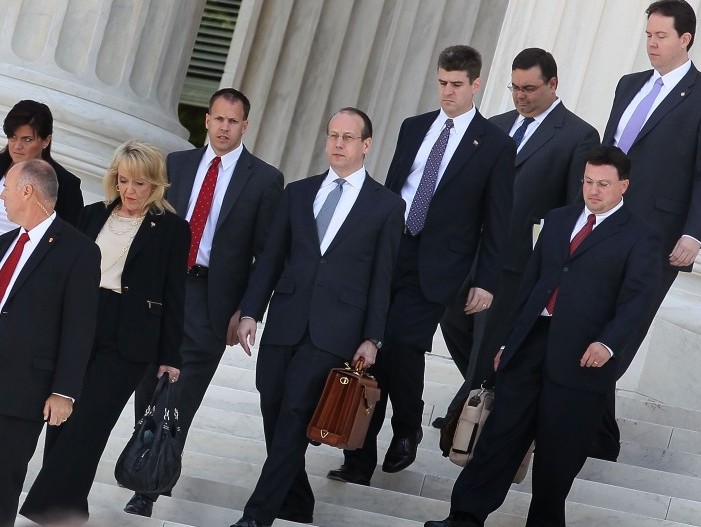WASHINGTON—Supreme Court justices did not seem persuaded this week by the Federal government’s argument that Arizona’s aggressive immigration law would conflict or undermine federal authority.
During oral arguments at a hearing April 25, former Bush administration Solicitor General Paul Clement argued that Arizona’s Support Our Law Enforcement and Safe Neighborhoods Act (S.B. 1070), in seeking to identify illegal aliens, is only enforcing existing federal immigration law.
But Solicitor General Donald Verrilli Jr., arguing for the federal government, said that the likely result of mass incarcerations of people—some here legally but without papers in hand—usurps the executive branch’s authority. Verrilli said the president has exclusive responsibility as stated in the Constitution to enforce U.S. immigration law, and Arizona’s law would adversely impact U.S. foreign policy.
Verrilli suggested there could be retaliation against U.S. citizens in foreign countries due to Arizona’s law, mentioning Mexico as an example. Between 60 to 70 percent of the people who are deported are sent back to Mexico, and we need Mexico’s cooperation to remove them, he said.
The controversial S.B. 1070 was passed in 2010 because proponents believed the federal government was not doing nearly enough in preventing illegal immigration and deporting illegal aliens, who annually cost the state hundreds of millions of dollars in social services, increased crime, and jobs.
The stated goal of S.B. 1070—“attrition through enforcement”—is to drive illegal immigrants out of Arizona by making life difficult enough for them they will want to leave.
But before the state law could be enforced, the federal government went to court to block it, arguing that the legislation would preempt federal immigration laws. Lower courts agreed, and Arizona subsequently appealed to the Supreme Court.
A few other states—Alabama, Georgia, South Carolina, and Utah—have passed similar laws, some with enforcement provisions stronger than Arizona’s. These states face court challenges as well, and are watching to see how the Supreme Court decides.
Described as the most controversial provision in the Arizona law, section 2(B) requires Arizona law enforcement officers to verify the immigration status of every person who is stopped, detained, or arrested “where a reasonable suspicion exists that the person is an alien and unlawfully present in the United States.”
The individuals are held until they can prove citizenship or lawful status.
Liberal justices appeared most concerned over the length of detainment while checking immigration status. Clement assured the court that the Arizona law “has to be implemented in a way that’s consistent with ... both immigration law and civil rights law.” Clement cited data from federal enforcement that an immigration status inquiry takes, on average, about 10 minutes.
Verrilli later disputed the wait time. He said that while it is true that it takes 10 minutes to process the status checks, one must get in line, and the queue takes an additional 60 minutes. The average wait time is 70 minutes, he said.
Verrilli noted that except for persons who have U.S. passports, there is no citizen database, so wait times could be substantial.
Unconvincing Argument
“The framers vested in the national government the authority over immigration because they understood that the way this nation treats citizens of other countries is a vital aspect of our foreign relations,” Verrilli argued.
Justice Antonin Scalia countered that the national government is still in charge. “Arizona is not trying to kick out anybody that the federal government has not already said do not belong here.”
Chief Justice John Roberts didn’t see how active state enforcement of federal laws would affect federal government priorities. “All it does is notify the federal government [that] here’s someone who is here illegally; here’s someone who is removable. The discretion to prosecute for federal immigration offenses rests entirely with the [U.S.] Attorney General. ... That’s why I don’t see the problem with 11 section 2(B).”
“You can see it’s not selling very well—why don’t you try to come up with something else? Because … as the Chief [Justice] has said to you, it’s not that it’s forcing you to change your enforcement priorities,” Justice Sonia Sotomayor said. “You don’t have to take the person into custody. So what’s left of your argument?”
Other provisions in the Arizona law may be vulnerable. Lyle Denniston, who has covered the high court for 52 years, writes, “It appeared, overall, that the only way an observer could find that any part of the Arizona law was at risk was to read between the lines, relying upon some hints that maybe the state had gone too far by creating its own new brand of crime for someone who violated a federal immigration provision.”
For example, Chief Justice Roberts observed that the penalties on illegal aliens taking a job “expand beyond the federal government’s determination about the types of sanctions that should govern the employment relationship.” Clement conceded that the provision has no direct analog in federal law, but denied that was pre-emption.
The Supreme Court’s decision is expected in June, but the issue will not be fully resolved. According to Denniston, there will be further challenges in lower courts when the case is returned to them. Among the challenges that the High Court did not consider was the Arizona law providing police authority to arrest and hold people because they “look” like illegal aliens, or “racial profiling.” The federal government’s case does not raise this issue.
Justice Elena Kagan disqualified herself from the case presumably because she worked in the Justice Department on the case before stepping up to the Supreme Court. Because the federal government won in the lower court, a minimum 5 to 3 vote is required to uphold the Arizona law. A 4-4 split would mean the federal court’s bar on enforcement would stand.






